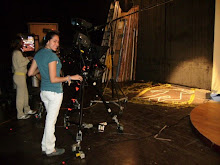 Laurel and Hardy are two famous movie characters of the 30`s, 40’s and 50's. They are well known for their differences in weight as you can see in the picture on the left. In case you don’t know them, they are popularly known as Thin (Stan Laurel) and Heavy (Oliver Hardy), the most famous pair of comedians of that time during which they performed almost ninety films.
Laurel and Hardy are two famous movie characters of the 30`s, 40’s and 50's. They are well known for their differences in weight as you can see in the picture on the left. In case you don’t know them, they are popularly known as Thin (Stan Laurel) and Heavy (Oliver Hardy), the most famous pair of comedians of that time during which they performed almost ninety films.
Stan Laurel (The thin), whose real name was Arthur Stanley Jefferson, was born in Ulverston, England, and began his career as a comedian in the theater as a substitute for Charlie Chaplin in Fred Karno theater company. He move to America in 1910 and made his first appearance in the film industry in the movie Nuts in May (1917). In 1921, during his work as an actor he met Oliver Hardy while both rolled the film The Lucky Dog, although they not were a partner until 1927.
For the other hand, Oliver Hardy (The Heavy) born on January 18 of 1892. Being the son of a lawyer, graduated from the University of Georgia and followed the same career of his father until he began his true vocation in an amateur theater. In 1915 he worked in a film for the company Lubin and, after a trip to Australia, he worked for the company Pathé. Between 1918 and 1925 was an actor in the company Vitagraph films and then went a comedian of Larry Semon. In 1925 he moved to the producer Hal Roach, where he met Stan Laurel.
Laurel and Hardy debuted as a couple with the short Slipping Wives. Hal Roach was the one who had the idea to combine the fat comedian with the thin one like an obvious and easy funny element; but was the chemistry that emerged between both that became them in the one of the most famous comedians pairs of the cinema.
The following shorts, alter Slipping Wives, are the best of their production. In 1931, they began with films and, because of them, they achieved worldwide fame. In 1939 they split up and Hardy was the leading actor of Zenobia, with Harry Langdon; and made, too, some supporting roles in Wagner and Frank Capra’s films. However, Laurel and Hardy were like a violin and bow, individually they were not very far, but together they were a diamond in the rough, so a few months later they start to work together again. In this way, in 1952 they made a film in France and then they spent more time to the theater and television.
The key of their success, lightning since their earlier comedies, lay in the perfect exploitation of the funny of their contrasting physicals and characters. So, while Laurel representing a guy with clumsy movements, Hardy played a serious character who was desperate with the blunders of his partner. Laurel was thin, lunatic, scatterbrained, coward, shy, but always charming. Hardy, for the other hand, was bold and pretentious, but never unpleasant.
In real life, however, the personalities of Laurel and Hardy were very different from those shown on the screens. Hardy was happy and good-natured, more concerned about horse racing than for its movies. Instead, Stan Laurel was the brain of their filmography, a domineering organizer, creator and undisputed screen comic genius, whose influence marked the career of Jerry Lewis, another lunatic comedian, and even the career of Dick Van Dyke, a famous American television star. As well, Hardy was happily married with Virginia Lucille Jones while Laurel, incorrigible womanizer, had five marriages and many lovers.
All in all, the couple Laurel and Hardy had a lot of influence in the America’s comedy. Among his many films, mostly directed by Leo McCarey, stand out Fra Diávolo (1933), Laurel y Hardy in the west (1937) and Students at Oxford (1940).
 In English III, with the professor Lissette Lunar, I had the opportunity to improve my writing, my reading and also my oral qualities. The activities we had done throughout the semester let me learn to redact in an academic way. Because, in first place, I had read some texts that I used as reference, for example: Distance Education and Albert Bandura. At the same time, I practiced writing several texts, some in class and others making use of technologic tools like modulo 7 and this blog. In this mode I was able to identify my weakness and work on them.
In English III, with the professor Lissette Lunar, I had the opportunity to improve my writing, my reading and also my oral qualities. The activities we had done throughout the semester let me learn to redact in an academic way. Because, in first place, I had read some texts that I used as reference, for example: Distance Education and Albert Bandura. At the same time, I practiced writing several texts, some in class and others making use of technologic tools like modulo 7 and this blog. In this mode I was able to identify my weakness and work on them. 







